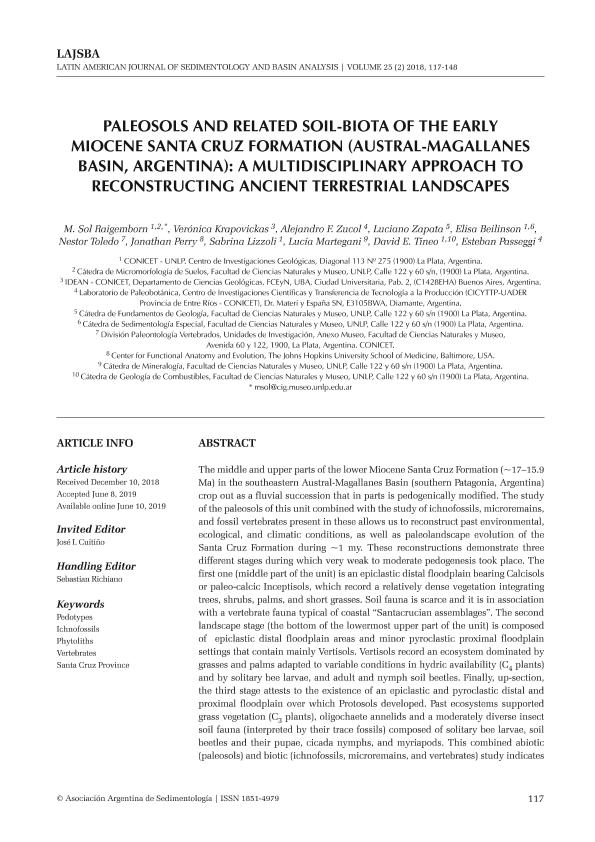Artículo
Paleosols and related soil-biota of the early Miocene Santa Cruz Formation (Austral-Magallanes Basin, Argentina): a multidisciplinary approach to reconstructing ancient terrestrial landscapes
Raigemborn, María Sol ; Krapovickas, Verónica
; Krapovickas, Verónica ; Zucol, Alejandro Fabián
; Zucol, Alejandro Fabián ; Zapata, Luciano
; Zapata, Luciano ; Beilinson, Elisa
; Beilinson, Elisa ; Toledo, Néstor
; Toledo, Néstor ; Perry, Jonathan; Lizzoli, Sabrina
; Perry, Jonathan; Lizzoli, Sabrina ; Martegani, Lucía; Tineo, David
; Martegani, Lucía; Tineo, David ; Passeggi, Esteban
; Passeggi, Esteban
 ; Krapovickas, Verónica
; Krapovickas, Verónica ; Zucol, Alejandro Fabián
; Zucol, Alejandro Fabián ; Zapata, Luciano
; Zapata, Luciano ; Beilinson, Elisa
; Beilinson, Elisa ; Toledo, Néstor
; Toledo, Néstor ; Perry, Jonathan; Lizzoli, Sabrina
; Perry, Jonathan; Lizzoli, Sabrina ; Martegani, Lucía; Tineo, David
; Martegani, Lucía; Tineo, David ; Passeggi, Esteban
; Passeggi, Esteban
Fecha de publicación:
07/2018
Editorial:
Asociación Argentina de Sedimentología
Revista:
Latin American Journal of Sedimentology and Basin Analysis
ISSN:
1669-7316
Idioma:
Inglés
Tipo de recurso:
Artículo publicado
Clasificación temática:
Resumen
The middle and upper parts of the lower Miocene Santa Cruz Formation (~17–15.9 Ma) in the southeastern Austral-Magallanes Basin (southern Patagonia, Argentina) crop out as a fluvial succession that in parts is pedogenically modified. The study of the paleosols of this unit combined with the study of ichnofossils, microremains, and fossil vertebrates present in these allows us to reconstruct past environmental, ecological, and climatic conditions, as well as paleolandscape evolution of the Santa Cruz Formation during ~1 my. These reconstructions demonstrate three different stages during which very weak to moderate pedogenesis took place. The first one (middle part of the unit) is an epiclastic distal floodplain bearing Calcisols or paleo-calcic Inceptisols, which record a relatively dense vegetation integrating trees, shrubs, palms, and short grasses. Soil fauna is scarce and it is in association with a vertebrate fauna typical of coastal “Santacrucian assemblages”. The second landscape stage (the bottom of the lowermost upper part of the unit) is composed of epiclastic distal floodplain areas and minor pyroclastic proximal floodplain settings that contain mainly Vertisols. Vertisols record an ecosystem dominated by grasses and palms adapted to variable conditions in hydric availability (C4 plants) and by solitary bee larvae, and adult and nymph soil beetles. Finally, up-section, the third stage attests to the existence of an epiclastic and pyroclastic distal and proximal floodplain over which Protosols developed. Past ecosystems supported grass vegetation (C3 plants), oligochaete annelids and a moderately diverse insect soil fauna (interpreted by their trace fossils) composed of solitary bee larvae, soil beetles and their pupae, cicada nymphs, and myriapods. This combined abiotic (paleosols) and biotic (ichnofossils, microremains, and vertebrates) study indicates that several factors controlled the landscape evolution during the early Miocene of southeastern Patagonia. Highly aggrading fluvial conditions, variations in the position in the floodplain and in sedimentation/pedogenesis ratio, the input of pyroclastic materials, the length of landscape stability, changing hydrologic conditions, and fluctuations of wetter and drier phases in a context of relatively warm and humid climate, seem to be the main factors controlling the landscape
Palabras clave:
Pedotypes
,
Ichnofossils
,
Phytoliths
,
Vertebrates
,
Santa Cruz Province
Archivos asociados
Licencia
Identificadores
Colecciones
Articulos(CICYTTP)
Articulos de CENTRO DE INV.CIENT.Y TRANSFERENCIA TEC A LA PROD
Articulos de CENTRO DE INV.CIENT.Y TRANSFERENCIA TEC A LA PROD
Articulos(CIG)
Articulos de CENTRO DE INVEST.GEOLOGICAS (I)
Articulos de CENTRO DE INVEST.GEOLOGICAS (I)
Articulos(IDEAN)
Articulos de INSTITUTO DE ESTUDIOS ANDINOS "DON PABLO GROEBER"
Articulos de INSTITUTO DE ESTUDIOS ANDINOS "DON PABLO GROEBER"
Citación
Raigemborn, María Sol; Krapovickas, Verónica; Zucol, Alejandro Fabián; Zapata, Luciano; Beilinson, Elisa; et al.; Paleosols and related soil-biota of the early Miocene Santa Cruz Formation (Austral-Magallanes Basin, Argentina): a multidisciplinary approach to reconstructing ancient terrestrial landscapes; Asociación Argentina de Sedimentología; Latin American Journal of Sedimentology and Basin Analysis; 25; 2; 7-2018; 117-148
Compartir



